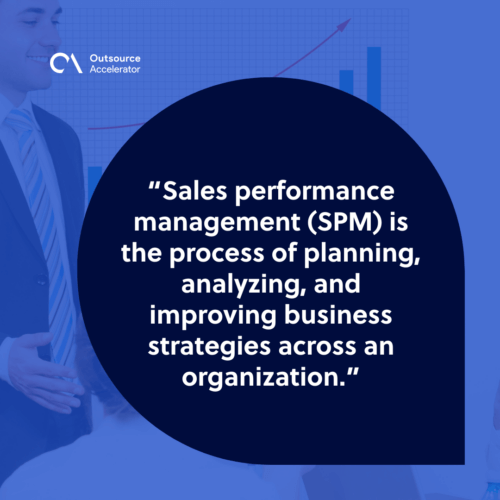Sales performance management 101

Achieving optimal sales performance is a recurring challenge for businesses in crowded, competitive markets.
Sales performance management is essential for those seeking to maximize sales efficiency and drive revenue growth. A well-designed strategy can empower sales teams to reach their targets and exceed customer expectations consistently.
This article discusses the fundamentals of sales performance management. We’ll delve into its significance, key components, and how your organization can use it for the highest impact.
What is sales performance management?
Sales performance management (SPM) is the process of planning, analyzing, and improving business strategies across an organization. It places a special emphasis on guiding and managing sales representatives to help them achieve company goals and objectives.
The goal of sales performance management is to create a well-coordinated and high-performing sales force. The team should be able to adapt to market dynamics, meet customer needs, and contribute to sustained business growth.
By implementing effective SPM strategies, companies can improve their sales efficiency, gain control over core sales actions, and optimize sales performance.

Components of sales performance management
Sales performance management encompasses several interconnected components that work together to optimize sales effectiveness.
These components include:
- Goal setting – Goals should be SMART to provide a roadmap for individual and team success.
- Sales planning – This helps identify the right opportunities and allocate resources accordingly.
- Performance measurement – Tracking and evaluating KPIs against set goals is crucial in sales performance management.
- Incentive compensation – Design a well-structured and motivating incentive compensation plan for driving sales performance and aligning individual efforts with company goals.
- Sales coaching and feedback – These programs help sales professionals enhance skills, stay updated on product knowledge, and adapt to market trends.
- Motivation and recognition – Create a positive work environment that recognizes accomplishments to boost morale and foster a culture of success.
- Territory management – Effectively allocating sales territories and setting realistic quotas ensures a balanced distribution of work and achievable targets.
- Sales analytics – Sales analytics can inform decision-making and drive improvements.
By implementing these components, organizations can establish a holistic sales performance management framework that contributes to long-term benefits.
Why is sales performance management important?
The strategic framework of sales performance management can be of immense importance in the following areas:
Optimized performance
Sales performance management helps companies analyze and assess their sales performance. Implementing an SPM process allows businesses to track their progress and identify areas for improvement.
This optimization of sales performance leads to increased productivity, efficiency, and, ultimately, higher revenue generation.
Goal alignment
Sales performance management enables organizations to set clear goals and objectives for their teams. It ensures that all goals are aligned with the company’s broader objectives.
This alignment creates a unified focus, directing sales efforts toward activities that directly contribute to company success.
Strategic decision-making
Finally, sales performance management provides valuable insights for sales forecasting and planning. Data analytics gives you information about sales trends, customer behaviors, and market dynamics.
Businesses can make accurate decisions to allocate resources and plan for future growth.

How to implement sales performance management
Here are the key steps to ensure a systematic integration of SPM within an organization:
1. Assessment and planning
Begin by conducting a thorough assessment of your current sales processes and management systems. Identify strengths, weaknesses, opportunities, and threats.
From this assessment, you can begin to develop a detailed plan outlining your SPM implementation.
2. Define clear objectives and metrics
Clearly define the objectives of the SPM implementation. Establish measurable key performance indicators (KPIs) that align with overall business goals.
Having clearly defined objectives provides a sense of direction and focus for the sales team.
Examples of KPIs include:
- Sales targets
- Conversion rates
- Average deal size
- Customer satisfaction ratings
- Revenue growth targets
3. Develop performance measurement systems
Implement systems and tools that capture and analyze sales performance data. This may involve CRM software, sales dashboards, or reporting tools.
The technology you choose should support the essential components of SPM. Ensure that the chosen systems integrate seamlessly with your existing ones.
4. Design incentive compensation plans
Create incentive compensation plans that motivate sales professionals to achieve their targets. Determine commission structures, bonuses, and recognition programs that are fair, transparent, and properly communicated to the sales team.
5. Provide sales training and coaching
Invest in continuous training and coaching programs to enhance the skills and knowledge of the sales team. Provide them with the necessary techniques to excel in their roles, and don’t forget to offer constructive feedback.
Continuous development ensures that the sales force remains adaptable to whatever challenges may arise.

6. Enable collaboration and communication
Foster collaboration and communication among sales team members and other departments. Encourage knowledge sharing, best practices, and effective communication channels.
Creating this kind of culture helps generate new ideas and improves overall sales effectiveness.
7. Integrate sales analytics
Leverage data and analytics tools to gain insights into sales performance, trends, and forecasting.
Sales analytics provide valuable information for decision-making and identifying areas for improvement.
8. Review and adjust
Regularly review the effectiveness of your sales performance management program. Monitor progress, evaluate results, and make necessary adjustments.
Remember that this is an ongoing process that requires continuous refinement.
Improving efficiency with sales performance management
Improving your efficiency with SPM should be a key priority for most. It’s a transformative strategy for organizations committed to achieving sustainable growth.
By aligning sales processes with clear objectives, implementing analytics, and fostering a culture of continuous improvement, SPM allows teams to operate at the highest level.







 Independent
Independent




